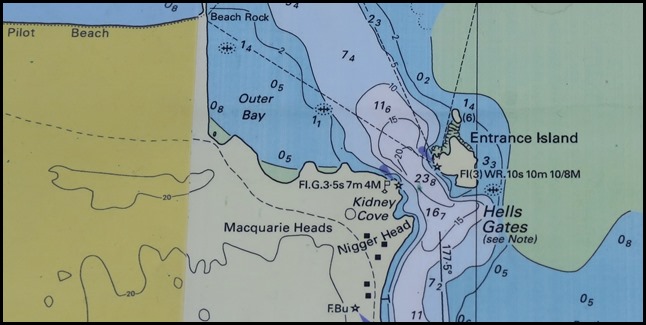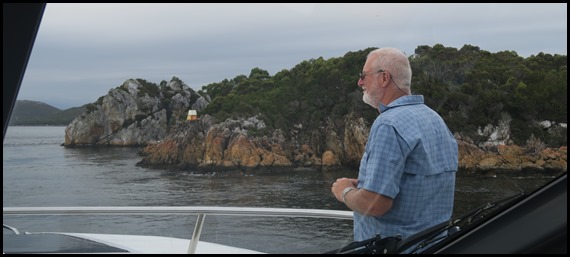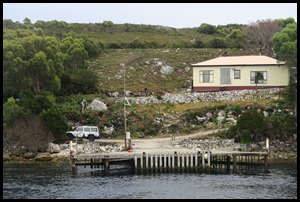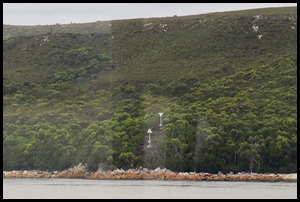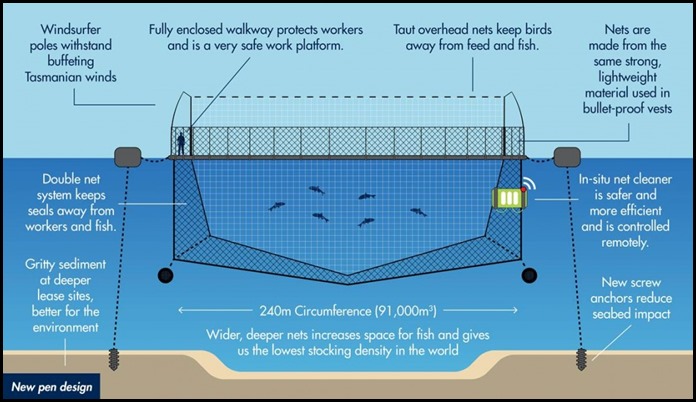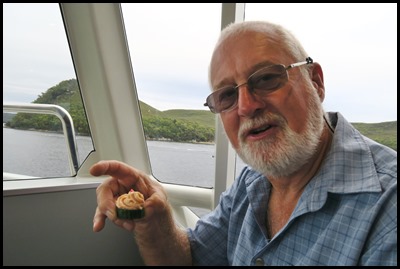To Hell's Gate

|
To Hell's
Gate
 We jumped up full of beans, ate
breakfast and left Mabel for the short walk to the quayside. Along the way we
stopped to enjoy the still of the
morning.
  So peaceful and
quiet.
  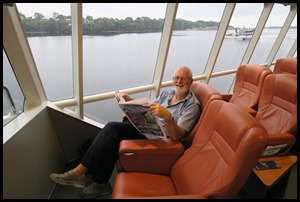 Bear about to
board the Lady Jane Franklin II, at the top
of the stairs and settled with the paper.
Offered a glass of fizz by our lovely hostess Amanda, rude not to say ‘yes’.
It’s going to be a lovely day.
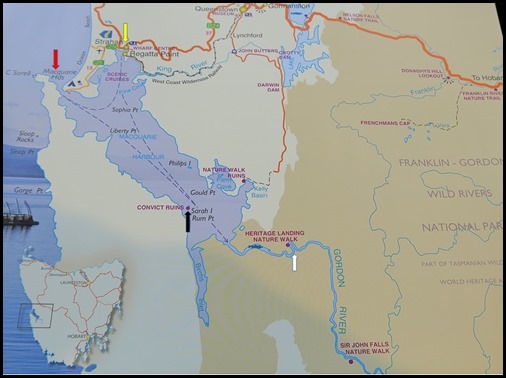 Beginning our
journey in Strahan (yellow arrow), we would head out of Hell’s Gate (red
arrow) then up the Gordon River as far as Heritage Landing (white arrow) where
we will bimble the boardwalk and finally explore the ex-convict detainment Sarah
Island (black arrow) before heading back to Strahan.
   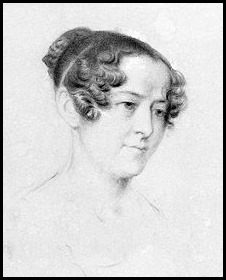  While the other passengers settled
(we only had nine others on the top deck) we had time to read the specs of the boat, look up who she was named after and look at the layout.
 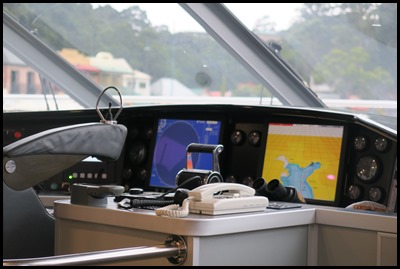 The captain’s
seat. Always amazing that such a big girl should have such a tiny joystick set on the right arm of the
chair.
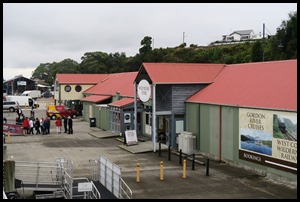 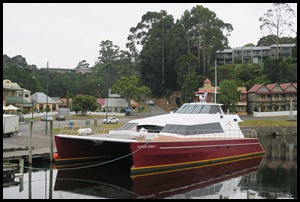 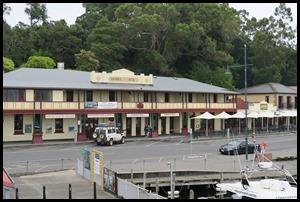 The quayside, the other cruise boat – Ocean Spirit and Hamers
Hotel.
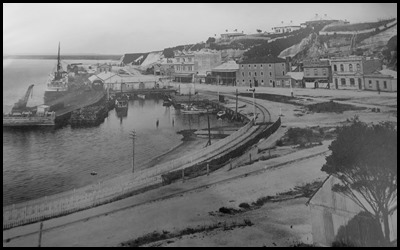  Then and now.
 A girl coming
in.
 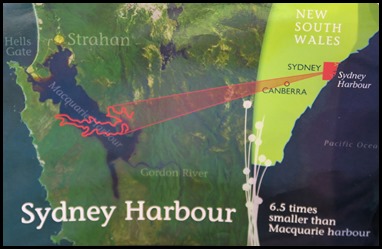 Macquarie
Harbour in comparison to Sydney Harbour is
enormous, but the entrances couldn’t be more different. The
narrow entrance to the huge Macquarie Harbour was discovered in 1815. Within
a year, timber cutters moved in and navigating the narrow entrance and its
sandbar was an essential hazard to getting the timber out to Hobart. In
the 1890's the discovery of silver and lead at Zeehan greatly increased the
traffic entering the harbour, it was then that works were undertaken to improve
the entrance.
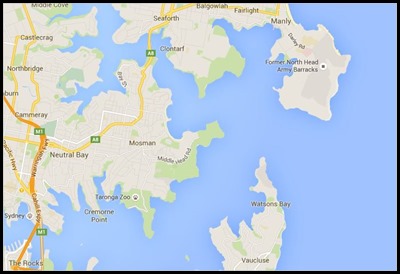 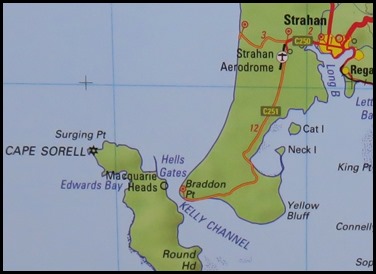 The gap between
the North and South Heads going into Port Jackson is sixteen hundred and
nine metres wide, the gap at Hell’s Gate is one
hundred and twenty metres........but if you take out the shallow bits at each
edge – much, much narrower. So pleased Beez doesn’t have to do
it.
 We set off and soon we could see
Hell’s Gates in the distance, it is a notoriously shallow and dangerous channel
entrance to the harbour. The actual channel is between Macquarie Heads on the west and Entrance
Island on the east (the main length of the harbour runs
southeast of Hells Gates).
 There is a wider area of
water between Entrance Island and Macquarie Head, but it is too shallow
to get a boat over. The
sand spit on the other side proves how shallow the water would be without
the training wall.
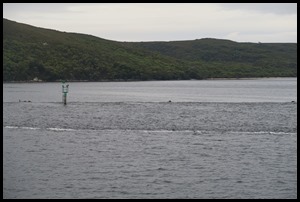 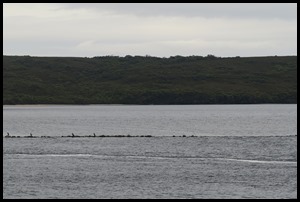 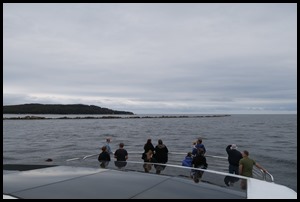 The captain pointed out a the hand
built training wall and explained that untamed nature was a force to be
conquered for survival. Near the harbour mouth, the three kilometres ‘training
wall’ was an engineering marvel that works just as well today. It acts as a
giant funnel, speeding up the tidal flow and forcing it along the rock wall to
scour out sand. It keeps the channel clear without the need for dredging, making
it safe for shipping. It was a test of nerves for designer, Captain William
Napier Bell, who had only his small pilot model to go on. Three hundred men
filled the wall by hand in a two-year marathon in the 1890’s, packing it with
thousands of tons of stone in the hope that it would work. Without the wall and
the associated breakwater to make shipping safe, Strahan would not
exist.
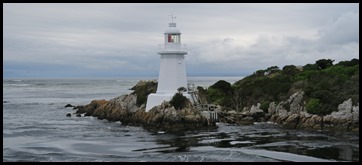 The lighthouse on Entrance Island. A signal station was erected near Cape Sorell in 1822 to indicates
conditions entering the harbour. It was manned by convicts from the newly
established penal settlement at Sarah Island. in
1891, a light was exhibited from two white six sided wooden towers, one on the
western side of Entrance Island, and the other on Bonnet Island. In 1899 a light
was constructed a Cape Sorell. The
Entrance Light was powered by gas until 1977, when solar panels and batteries
took over.
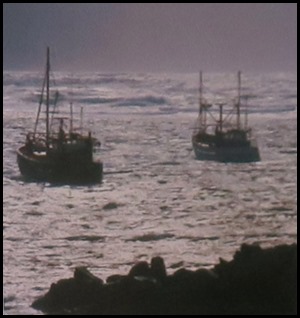 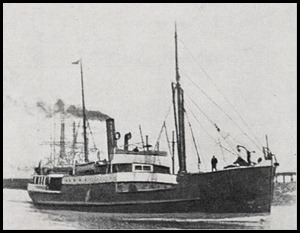 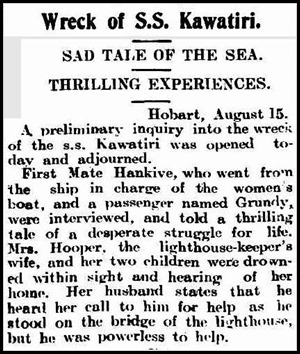 Next stop, South America or if you turn left you’ll
eventually reach Antarctica. There is no room for error here at Hell’s Gate.
When the Southern Ocean unleashes its power, seas can churn more than 20 metres
high as measured by an official buoy just off the coast. Local fishermen, who stay out at sea for two to three weeks
show it great respect. The skipper told us how the schooners and clippers in
olden days would have to time their entrance, one had to sail up and down
outside for two weeks before it was safe to enter. Sixteen ships have been
wrecked here and even whales have difficulty with this dangerous coast, the
scene of many strandings. An assistant lighthouse keeper on Entrance Island lost
his entire family before his eyes when his wife, five-year-old and a second boy
drowned when the SS Kawatiri floundered here
in 1907. They were returning from a holiday and were washed away during an
attempted lifeboat rescue. A newspaper clipping about
the sad event.
 Our captain lined us
up.
There was the Southern
Ocean.
  Bitey rocks to the left and
an excited Bear to the right. And
through we went. The wind was was incredibly cold and very
blustery.
 Bear too pleased to notice the
biting wind as we turned to go back
in.
Hells Gates viewed from outside. Entrance Island is on the left. Bonnet Island lighthouse is visible in the distance.
Wiki Says: Braddon Point is the name of the feature on the eastern shore, while the shallow water south of the point is named Fraser Flats, and the channel adjacent to the breakwater is known as Kelly Channel. Name: The name of the channel relates to the original convicts' claim that it was their point of 'entrance to Hell', their Hell being the Macquarie Harbour Penal Station on Sarah Island and the outlying surrounds of the harbour. Other records indicate the name was used due to the enormous rush of the tides through the entrance to the harbour which can create very dangerous conditions. Breakwater and Channel: Between 1900 and 1902 the Macquarie Harbour Entrance Works involved the building of a breakwater and the channel was dredged. Parts of the breakwater can still be seen despite the passage of time. The Strahan Marine Board was involved with the monitoring of the mouth until 19 May 1970, when the Hobart Marine Board took over.
Charts: Due to the precarious entrance, and the changes in the hydrology of the area, charts and maps were updated regularly while Strahan was a port of importance. Some maps are now available online.
About to go back in.
The captain pointed to the old pilot’s house, the old head lighthouse keepers house and the leading marks he had used to line us up.
After the excitement of Hell’s Gates the captain told us all about the salmon and trout industries as we passed our first fish farm.
These boats can hoover up the fish or be used to pump fish food into the pens.
The sea bed friendly pens are huge.  The salmon factory we had walked past first thing this
morning says: Our Huon Salmon and Ocean Trout is Grown in
Tasmania.
Since the first harvest of farmed Atlantic salmon in 1986, the aquaculture industry has grown to become the leading farming activity in Tasmania. Atlantic salmon, salmo salar, is one of several varieties of salmonidae and it is important to note that other species have adopted the characteristics of Atlantic salmon but do not have the qualities and flavour we have come to love today. Atlantic salmon was first introduced to Tasmania and New South Wales for sport fishing in the 1800’s but a population was never established. The next attempt to introduce the species to Tasmania was not until the 1980’s when fertilised Atlantic salmon eggs were purchased from the Gaden Hatchery in Jindabyne, New South Wales which originated from Nova Scotia, Canada in the 1960’s. In 1985, it was determined that the health of the new stock was at a standard they could introduce to the sea, with 36,000 fish included in the first transfer. Huon Aquaculture began farming not long after in 1987 and has grown to become Australia’s signature producer of Atlantic salmon with approximately 480 employees. The rigorous testing which occurred in the 1980’s and Huon’s continued dedication to biosecurity and environmental standards has ensured that we produce the world’s most loved salmon.
The Tasmanian Salmonid Growers Association says: Farmed salmon has significant economic benefits for the State – it’s worth almost $550 million a year and employs thousands of Tasmanians directly and indirectly.
Our canapés arrived just then, Bear’s all fancy, mine plain – both absolutely delicious. Time to sit back, sip fizz and enjoy the cruise to Heritage Landing.
ALL IN ALL THRILLED TO HAVE DONE HELL’S GATE A VERY IMPRESSIVE BUT NARROW ENTRY TO SUCH A BIG AREA |


